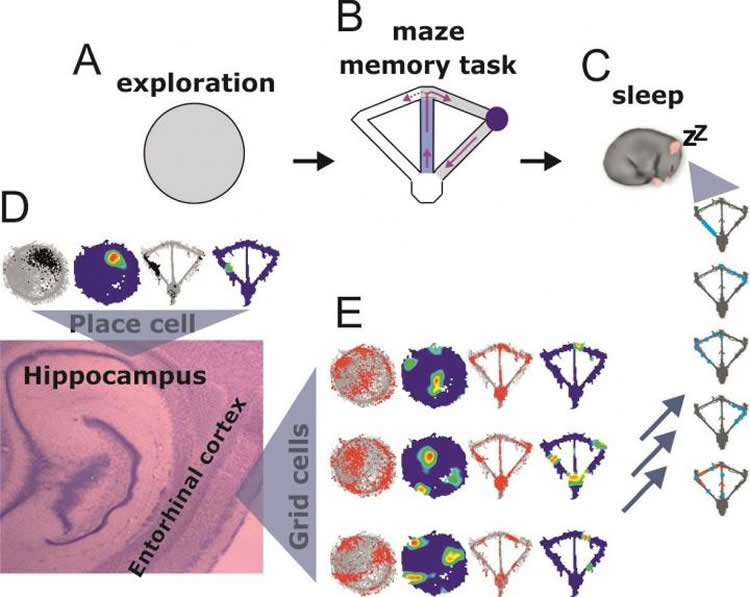Summary: According to researchers, the entorhinal cortex can replay memories of movement without hippocampal input.
Source: IST Austria.
Entorhinal cortex acts independently of the hippocampus in remembering movement .
Until now, the hippocampus was considered the most important brain region for forming and recalling memory, with other regions only contributing as subordinates. But a study published today in Science finds that a brain region called entorhinal cortex plays a new and independent role in memory. A team of researchers led by Jozsef Csicsvari, Professor at the Institute of Science and Technology Austria (IST Austria), showed that, in rats, the entorhinal cortex replays memories of movement independent of input from the hippocampus.
“Until now, the entorhinal cortex has been considered subservient to the hippocampus in both memory formation and recall. But we show that the medial entorhinal cortex can replay the firing pattern associated with moving in a maze independent of the hippocampus. The entorhinal cortex could be a new system for memory formation that works in parallel to the hippocampus”, Jozsef Csicsvari explains.
When a spatial memory is formed, cells in the medial entorhinal cortex (MEC), especially grid cells, act like a navigational system. They provide the hippocampus with information on where an animal is and give cues as to how far and in what direction the animal has moved. Rats encode location and movement by forming networks of neurons in the hippocampus that fire together. When a memory is recalled for memory stabilization, the MEC has been considered as secondary to the hippocampus. In the hippocampus, such recall occurs during the so-called “sharp wave/ripples”, when neuronal networks fire in a highly synchronized way. According to the view prevailing until now, the hippocampus is the initiator of this replay and coordinates memory consolidation, while the MEC is just a relay post that spreads the message to other brain areas.

To ask whether replay also occurs in the MEC, the researchers studied memory recall in rats moving in a maze. They showed that neurons in the superficial layers of the medial entorhinal cortex (sMEC), a part of MEC that sends input to the hippocampus and contain the grid cells, fire during the memory task and encode routes as bursts of firing. Surprisingly, the authors find that replay firing in the sMEC is not accompanied by replay firing in the hippocampus. During both sleep and waking periods, the sMEC triggers its own replay and initiates recall and consolidation independent of the hippocampus. Joseph O’Neill, first author and postdoc in the group of Jozsef Csicsvari, explains how these results change the way we see memory formation: “The hippocampus alone does not dominate how memories are formed and recalled. Instead, the entorhinal cortex and the hippocampus are probably two systems for memory formation and recall. Despite being interrelated, the two regions may work in parallel. They may recruit different pathways and play different roles in memory.”
Funding: Funding from European Research Council.
Source: Elisabeth Guggenberger – IST Austria
Image Source: NeuroscienceNews.com image is credited to IST Austria.
Original Research: Abstract for “Superficial layers of the medial entorhinal cortex replay independently of the hippocampus” by J. O’Neill, C.N. Boccara, F. Stella, P. Schoenenberger, and J. Csicsvari in Science. Published online January 12 2017 doi:10.1126/science.aag2787
[cbtabs][cbtab title=”MLA”]IST Austria “New System For Forming Memories.” NeuroscienceNews. NeuroscienceNews, 12 January 2017.
<https://neurosciencenews.com/hippocampus-memory-formation-5933/>.[/cbtab][cbtab title=”APA”]IST Austria (2017, January 12). New System For Forming Memories. NeuroscienceNew. Retrieved January 12, 2017 from https://neurosciencenews.com/hippocampus-memory-formation-5933/[/cbtab][cbtab title=”Chicago”]IST Austria “New System For Forming Memories.” https://neurosciencenews.com/hippocampus-memory-formation-5933/ (accessed January 12, 2017).[/cbtab][/cbtabs]
Abstract
Superficial layers of the medial entorhinal cortex replay independently of the hippocampus
The hippocampus is thought to initiate systems-wide mnemonic processes through the reactivation of previously acquired spatial and episodic memory traces, which can recruit the entorhinal cortex as a first stage of memory redistribution to other brain areas. Hippocampal reactivation occurs during sharp wave–ripples, in which synchronous network firing encodes sequences of places. We investigated the coordination of this replay by recording assembly activity simultaneously in the CA1 region of the hippocampus and superficial layers of the medial entorhinal cortex. We found that entorhinal cell assemblies can replay trajectories independently of the hippocampus and sharp wave–ripples. This suggests that the hippocampus is not the sole initiator of spatial and episodic memory trace reactivation. Memory systems involved in these processes may include nonhierarchical, parallel components.
“Superficial layers of the medial entorhinal cortex replay independently of the hippocampus” by J. O’Neill, C.N. Boccara, F. Stella, P. Schoenenberger, and J. Csicsvari in Science. Published online January 12 2017 doi:10.1126/science.aag2787






